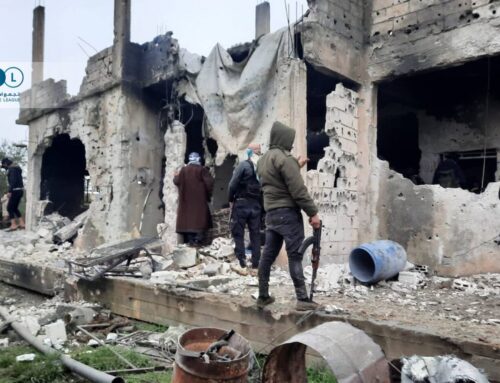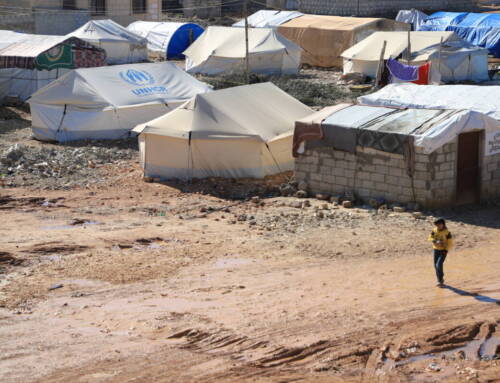Former FSA fighters help IS in battle for Deir e-Zor airport
December 10, 2014 Last week the Islamic State launched its […]
10 December 2014
December 10, 2014
Last week the Islamic State launched its second major attack against the Deir e-Zor military airport since it captured Deir e-Zor city and the majority of the eponymous province from the regime and Jabhat a-Nusra this past July.
The military airport is now the last major regime stronghold in the oil-rich eastern province.
Using a series of car bomb attacks–including one that detonated a tank–IS has now managed to penetrate the buffer zone surrounding the airport and capture a number of points in the area.
The regime is responding by launching an intense aerial campaign against IS positions in al-Jafra and the towns of al-Hawija and Marihiyak to the north of the airport, forcing IS fighters to withdraw from the military base’s vicinity, reported Al-Monitor on Tuesday.
Despite their gains, it will be difficult for IS to capture the airport, says a Deir e-Zor-based citizen journalist who goes by the pseudonym Abu Baraa Sharqi.
The regime still controls a series of military facilities and bases that are connected to the airport, with local residents enlisting in the National Defense Forces [pro-regime militia] to protect the area, Sharqi tells Syria Direct’s Mohammed al-Haj Ali.
Even the presence of former FSA fighters cannot help against the regime’s “scorched earth policy,” says Sharqi, who works with the pro-opposition media campaign Deir e-Zor Under Fire.
Q: What are you hearing and seeing about Deir e-Zor military airport?
There are dead bodies and severed heads hanging in the streets of the villages around the airport. The regime also defiles the bodies, stabbing the corpses in the areas under its control.
Q: Are there any other opposition groups, such as the FSA or Jabhat a-Nusra fighting alongside IS in the battle for the airport?
The situation in Deir e-Zor is so complicated, and yes, there are factions from the FSA that are fighting on more than the half of the frontlines. The biggest proof is that more than 40 fighters from the FSA were killed in the past two days. All of them are either from the FSA or are civilians.
The people of Deir e-Zor know this, but because of the media’s fascination with IS, people outside Deir e-Zor do not know.
After IS captured FSA areas, it agreed with other opposition groups that they would stay on the frontlines in the fight against the Syrian regime. IS told them that it will support them with weapons during the battles, but it put forward certain conditions:
[The FSA] must surrender all of their heavy weapons and inform IS of all the light weapons that the FSA has. IS then gives the FSA their weapons when they go to fight and then retrieves the weapons from them when the battle finishes.
The FSA is not allowed to declare on social media and in news agencies that it fights with IS against the Syrian army and it cannot adopt any military stance [without IS] against the Syrian army.
Because of this, we see that IS takes credit for FSA’s efforts [against the regime].
Aside from this, we do not deny that some fighters from IS are on the frontlines, but the largest effort is on part of the FSA–who are the people of Deir e-Zor–because IS knows that protecting their families and freeing the city are the FSA’s goals for the revolution.
Q: There is contradictory news about what is happening at the airport.
The battle for the airport is an open battle and will not be easy for either side [to win] because of the topography in the area. The airport is connected to a series of military bases and facilities that are still under regime control.
The regime-controlled area starts from the east side of the airport to the mountain where there are military divisions, such as the Air Defense and a number of other Brigades. The line of regime divisions then stretches to the al-Talaea Camp and Brigade 137 in the southwest of Deir e-Zor. All these places are with the regime now.
Many people from the areas and villages surrounding the airport are now joining the National Defense Forces [pro-regime militia]. These people know the area very well – its strengths and weak points that could be used as possible points of infiltration.
On the other hand, IS and the rebels show determination and aggression in the battles. They are using car bombs against the airport walls. The regime built a buffer zone around the airport, but with car bombs, the rebels have managed to control some of the areas around the airport.
The rebels and IS captured some sites on the north front of the airport in the last two days in the Mazarea area. They also captured a number of sites around al-Jafra village, and those bordering the airport’s main gate like al-Hawija. The regime is using a ‘scorched earth’ policy in each place it loses in order to force IS and rebels to retreat from it. That happened in the Missile Brigade [regime base] and the mountain area. After the areas were liberated, the regime targeted them with fierce bombardment, causing the rebels and IS to retreat within hours [of their capture].
The battles between the IS and the regime are ongoing, but it is certain that IS has broken the regime’s buffer zone around the airport. Now it is an open front between the two sides, with only hundreds of meters between the two parts.

Q: IS is attacking the airport from two sides: the al-Jafra village from the north and the Missiles Brigade [military base] in the south – what is the difference between these two axes?
Yes, that is right. The idea is to open more than one front against the regime to distract its forces and their bombardment. It also increases the chances of breaking through the airport walls.
There is no difference between these two fronts from a geographical point of view.
The al-Jafra village borders the airport’s main gate in the north. Control of this gate will make it easy to reach the military residential quarters and cut the main road.
The Missiles Brigade is more of an open space. The regime can target the rebels there easily and they can directly strike the rebels. But if IS and rebels capture it, it will restrict the regime’s ability to bomb the rebels aerially. It will also make it easy for the rebels to target the air defense runway directly.
Q: What is the situation of civilians in the villages surrounding the airport? Are there many injured amongst the civilians?
With regard to the people in the villages around the airport, the majority of them have fled since the beginning of the military operations in the area.
For more from Syria Direct, like us on Facebook or follow us on Twitter.







